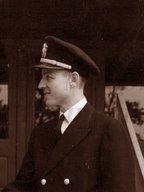
|

|
|
|
|
He preached in Nicademus and Hell's Bend, Arkansas, as a young minister, and later counseled and consoled young men as a chaplain on the shores of the Pacific. Born on Rockport Plantation near Belcher, Louisiana, George was the son of an overseer. As a youngster, he picked cotton and milked cows, finished high school in 1931, and enrolled at John Brown University, a Christian institution in Siloam Springs, Arkansas. At seventeen, he walked five miles to preach his first sermon in a small, country church. George earned degrees from Centenary College and Southern Methodist University. He tried to join the U.S. Navy in March of 1943, but weighed only 126 pounds--six pounds under the Navy's weight requirement of 132. The recruiting officer told him to start eating bananas and don't stop until the next morning. He returned and weighed 131. The recruiter gave him a pound. Joining the U.S. Marine Corps as a chaplain in the aviation section, he left California for Okinawa in March of 1945, and settled in at Yontan Field, within fifty yards of the command center. "Japanese were bombing us every moonlit night," he says. He recalls tracer bullets "two or three feet above my head" and hitting the tops of the foxhole. With his jeep, nicknamed "Holy Smoke," George held communion in the field and counseled men going into combat with such passages as Psalm 91 and Psalm 139. He also conducted services in a tent chapel, with a field organ the size of a suitcase. He states that he preached funerals for "five to eight to ten men a day. I took my bugler out there every day at sunset," he recalls. George served as wing chaplain, and went into Tokyo with the Second Marine Air Wing. He states that Louisiana Methodism furnished more chaplains for its size than any other conference in the nation. After the war he pastored several Methodist churches. |


